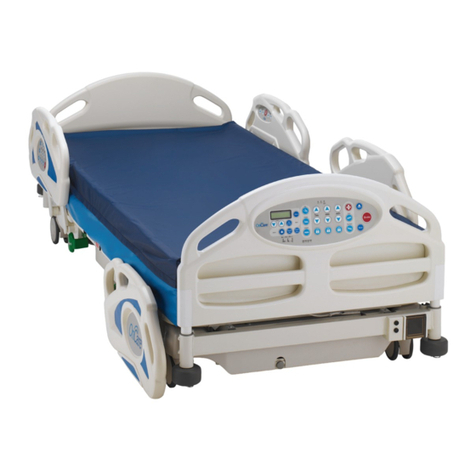
4
User Manual
Dolphin Fluid Immersion Simulation®System
Dolphin Fluid Immersion Simulation®is a registered trademark of Joerns
OnCare’ Dolphin System is suitable for the treatment
and prevention of all stages of pressure ulcers, for
patients who have been assessed to be at risk for
pressure ulcers, the complications of immobility and
for patients with healing grafts and ap sites.
The Dolphin FIS System is quiet, comfortable and
simple enough for single caregiver installation and
operation. As the Dolphin System is self-monitoring,
there is no need for direct intervention or manual
entry to adjust comfort settings. The system
allows manual adjustment of the comfort setting
to accommodate patient preference. After manual
adjustment, the Dolphin AutoVector Control Module
will optimize the immersion prole automatically at
the new comfort setting.
Additionally, the low friction surface materials
coupled with the shear-reducing aspects of the FIS
technology result in a surface system that effectively
manages both vertical and horizontal shear forces,
allowing the Dolphin FIS System to meet the comfort
and clinical requirements of your patients up to
1,000 lbs.1(250 lbs.2)
We have ensured that the Dolphin FIS System
addresses the three key areas in the treatment of
compromised skin: pressure redistribution, reduction
in friction and reduction in shearing forces.
Shear and Friction Reduction
Friction results when a patient’s skin rubs against
another surface. Shear injury occurs when the skin
is stationary in relation to the support surface, while
the underlying tissues and vessels are stretched
and damaged. The exterior surface of the Dolphin
FIS System therapy pad is constructed from a very
smooth nylon fabric with low friction and low shear
properties to protect the patient’s skin from these
damaging forces.
Indications for Use
Note: The selection of a pressure redistribution
surface should be based on each individual patient’s
clinical condition, diagnosis and/or co-morbidities.
The choice and use of a support surface is one
factor in a holistic program of wound prevention and
treatment.
Spinal Cord Injury
The Dolphin FIS System can be used for patients
with spinal cord injury once the acute injury has
been stabilized and these patients have been
accessed and cleared by the appropriate physician.
The Dolphin FIS System is not recommended for use
by patients with unstable spinal fractures.
Introduction
The Dolphin Fluid Immersion Simulation®(FIS)
System is an advanced therapy system designed to
provide state-of-the-art pressure redistribution by
simulating the effects of a body immersed in a uid
medium. The Dolphin System includes three key
components: proprietary software containing the
Dolphin FIS protocols, a microprocessor-containing
Dolphin AutoVector®control module, and the Dolphin
advanced support surface.
The Dolphin System automatically measures the
specic anthropometric characteristics of the
individual patient as they engage the support
surface. Based on active feedback measurements,
the Dolphin AutoVector control module monitors the
support surface more than 100 times per second
for any patient movement or surface changes. The
system’s software integrates this specic weight and
body contour data and directs automatic adjustments
to maintain an optimized three-dimensional support
surface environment. The result is an individualized
immersion prole, based on specic patient
measurements and movements, that creates a near
neutrally buoyant state on the support surface.
The Dolphin FIS System delivers many of the best
elements of air-uidized therapy such as three-
dimensional volumetric engagement and the
elimination of gradient shear forces, leading to
positive outcomes for aps, grafts, and pressure
ulcers. The Dolphin technology provides minimal
distortion to the body, while maintaining the normal
orientation of bone, muscle, and subcutaneous
tissue. The Dolphin FIS System has been
demonstrated to reduce the risk of pressure ulcer
formation as part of protocols for the prevention and
treatment of pressure ulcers.
The Dolphin FIS System is designed as a therapeutic
mattress system for patients weighing up to
1,000 lbs.1 It is customizable to t bed frames,
including bariatric bed frames, up to 48" wide.
The Dolphin System is also designed for specialty
surfaces (stretcher pad, wheelchair cushion) for
patients weighing up to 250 lbs.2
Warning: The risk of entrapment can arise when
equipment is placed on bed frames that leave gaps
of even a few inches between the therapy mattress
and the head panel, foot panel, and bed or side rails.
The equipment is NOT to be used when such gaps
are present. See “Important Precautions” section of
this manual.
1Mattress weight capacity only; total weight must not
exceed bed frame manufacturers’ specied load capacity,
and when paired with an appropriate surface.
2Specialty surface weight capacity only; total weight must
not exceed wheelchair manufacturers’ specied load
capacity, and when paired with an appropriate surface.




























